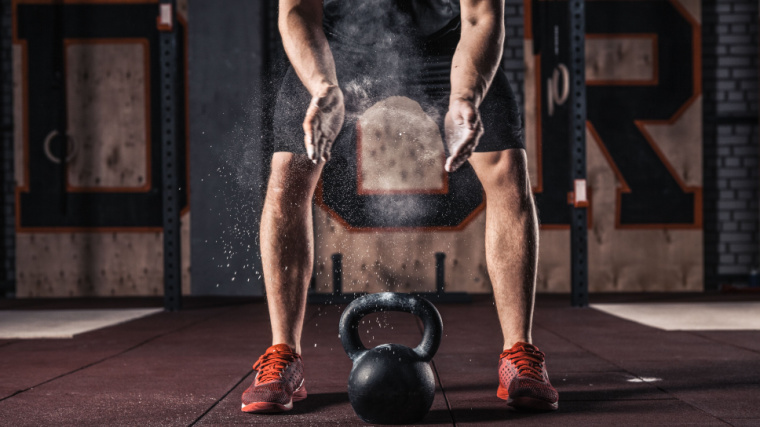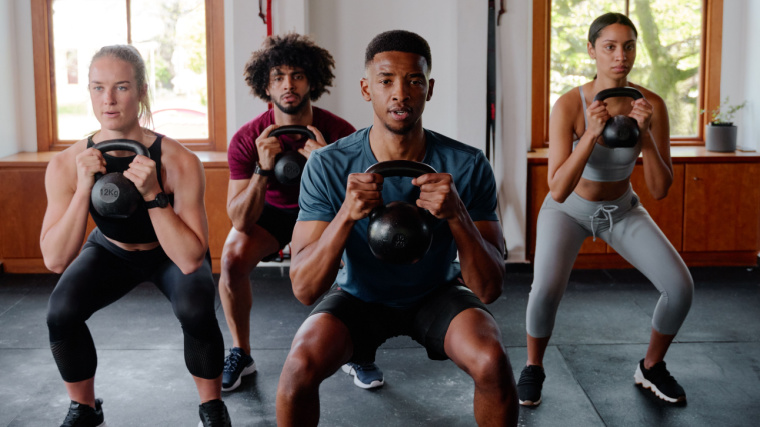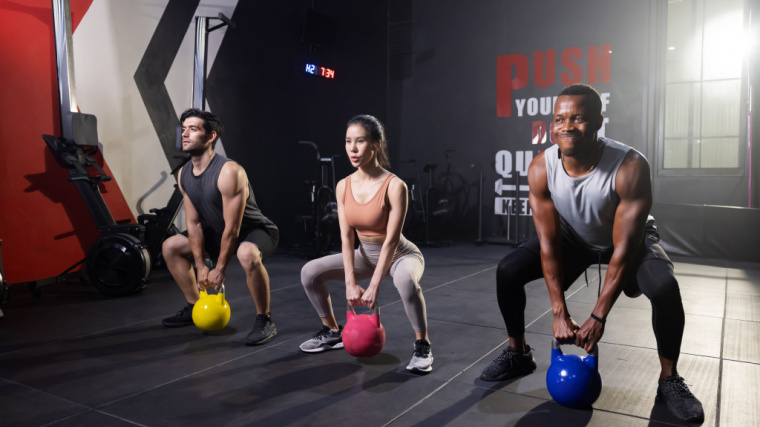Muscle Insider
New member
Even at its heaviest, the kettlebell may look like it’s too small for any real gains. But looks can be deceiving. Unlike a barbell and weight plates, you can store it pretty much wherever you want. It’s compact like a dumbbell, but its shape renders kettlebell exercises a game-changer for building dynamic, explosive strength in every plane of...
The post The Best Kettlebell Strength Workout for Heavier, More Powerful Lifts appeared first on BarBend.
Even at its heaviest, the kettlebell may look like it’s too small for any real gains. But looks can be deceiving. Unlike a barbell and weight plates, you can store it pretty much wherever you want. It’s compact like a dumbbell, but its shape renders kettlebell exercises a game-changer for building dynamic, explosive strength in every plane of motion.
Another bonus of kettlebells is that you can ramp up your heart rate, giving you cardio benefits while getting a solid full-body workout. You won’t just increase strength in one area — strength, when training with kettlebells, has quite a well-rounded definition.
 Credit: Dusan Petkovic / Shutterstock
Credit: Dusan Petkovic / Shutterstock
If you’re aiming to boost confidence and increase strength throughout your training and in activities of daily living, this kettlebell strength workout is for you.
Editor’s Note: The content on BarBend is meant to be informative in nature, but it should not be taken as medical advice. When starting a new training regimen and/or diet, it is always a good idea to consult with a trusted medical professional. We are not a medical resource. The opinions and articles on this site are not intended for use as diagnosis, prevention, and/or treatment of health problems. They are not substitutes for consulting a qualified medical professional.
The Workout
Oftentimes, when you’re on the search for a full-body kettlebell workout to help you get stronger, you may be exercising with space or time constraints. Kettlebell training is useful in a fully-equipped gym, but also extremely helpful in home gyms or other areas with limited space or time to work out.
That said, make sure you don’t rush through your dynamic warm-up. Just because you’re only working with one piece of equipment doesn’t mean you don’t have to get your joints, muscles, and lungs ready for action. It’ll only add a few minutes to your routine, and will be well worth it.
 Credit: Srdjan Randjelovic / Shutterstock
Credit: Srdjan Randjelovic / Shutterstock
[Read More: Dumbbells Vs. Kettlebells — Choose the Right Tool for Your Goals]
Since the principle aim here will be strength, you’re going to be lifting heavier weights than you will on a day when you’re training for higher volume or endurance. Select weights between 65 and 85 percent of your one-rep max. This will build upper body, lower body, and core strength in a low-impact workout for everyone from beginners to experienced kettlebell enthusiasts.
Take each exercise one by one, resting 45 to 60 seconds between sets and one to two minutes between exercises. This is a full-body workout split, meaning your entire body will be worked from legs and arms through your core.
Coach’s Tip: What if you don’t know your one rep max? For the greatest improvements in strength, the weight needs to feel very heavy. Consider how many repetitions you can complete before you’re approaching muscle failure — the weight you’re working with shouldn’t get you to failure in more than eight to 10 repetitions.
Everything from your grip, core, and legs to your single-arm strength and balance will benefit tremendously from this workout.
 Credit: oleksboiko / Shutterstock
Credit: oleksboiko / Shutterstock
[Read More: How to Do the Floor Press — Benefits, Variations, and More]
Depending on your preferences, experience level, and specific areas of focus, you can substitute alternative kettlebell exercises as needed. For example, you can swap a kettlebell push-up for the renegade row if you’re not yet stable enough to perform the full move.
A kettlebell overhead press can help you build upper body and core stability if you’re still building up to being able to perform a full Turkish get-up. Front-rack split squat variations will give your core an extra challenge, and you can swap in kettlebell deadlifts for swings if you’re aiming for something less dynamic.
How Often to Train With Kettlebells
If you’re wondering how often you should do this workout, it really depends on your fitness level, goals, recovery ability, and overall workout program. Consider aiming for two to four kettlebell strength training sessions per week. If you’re doing a full-body workout split, allow at least one day of rest between sessions to promote recovery and muscle growth to build strength.
The best strength training workouts have you working very close to your maximal effort — that includes kettlebell training for strength. Even one heavy or close to maximal lift a couple of times per week can tax your nervous system significantly. That’s especially true if you’re training your entire body with each kettlebell workout.
https://www.youtube.com/watch?v=lapZNTf6VHwVideo can’t be loaded because JavaScript is disabled: REP Fitness Adjustable Kettlebell Review (2023) — A Home Gym ESSENTIAL?? (https://www.youtube.com/watch?v=lapZNTf6VHw)
[Read More: The Best Upper Body Workouts for Strength, Muscle, Bodyweight Training, and More]
Because kettlebells are so accessible and you won’t be going as heavy as you would for barbell workouts, it might be tempting to train extremely often. You want to challenge your body to build strength but too much too soon can overwhelm your central nervous system. Here are some considerations:
If you answered ‘yes’ to many of these questions, it may be a good time to reassess your programming and talk to a qualified kettlebell coach or personal trainer to ensure your program prioritizes recovery for you.
The Benefits of Kettlebell Training to Increase Strength
Every time you pick up a kettlebell, you have the potential to get stronger. This workout has you hitting multiple muscle groups, compounding your strength in a whole-body experience. Whether you are working with a single kettlebell or two kettlebells, using kettlebell exercises to increase full-body strength is convenient and efficient.
Versatility and Convenience
Kettlebells are so versatile because you can use them for a wide variety of exercises, targeting different muscle groups and a wide range of fitness goals.
They are compact and portable, allowing for convenient home workouts, park workouts, and gym sessions. The best kettlebell exercises don’t require a lot of space — your wing span and the height of your body in the push-up starting position is really all the space you’ll need. Just a yoga mat with some breathing room around it will set you up for success.
 Credit: StratfordProductions / Shutterstock
Credit: StratfordProductions / Shutterstock
[Read More: How to Do the Sumo Goblet Squat — Benefits, Form, Variations, and More]
And because kettlebells typically provide a low-impact, full-body training experience, you can often get your workouts done relatively quickly. No weight plate changes to worry about or single-joint accessory movements to slow you down. So if you’re short on time as well as space, kettlebells have your back.
Joint Health and Injury Prevention
Kettlebell training, when done with proper form and technique, may help with improving joint stability and managing injury risk by strengthening supporting muscles and connective tissues. The kettlebell’s offset center of mass creates rotational forces that allow you to engage your stabilizer muscles critical for joint support.
https://www.youtube.com/watch?v=tzHu7G7qLn0Video can’t be loaded because JavaScript is disabled: 7 UNDENIABLE Benefits of Kettlebell Training (Full Body Strength, Low Impact Cardio, Flows & More!) (https://www.youtube.com/watch?v=tzHu7G7qLn0)
[Read More: Do the Romanian Deadlift for Bigger Legs and a Seriously-Strong Back]
The unilateral nature of many kettlebell exercises also allows you to maintain a more even, balanced approach to training so that your dominant side doesn’t take over. Muscle imbalances likely won’t develop as strongly as they might when you’re working with barbells all the time. This increased muscle balance can also help manage your risk of injury.
Increased Muscle Mass
Regular kettlebell training, especially with progressive overload (gradually increasing weights), can stimulate muscle hypertrophy. Even if your main goal is developing strength, muscle growth will likely follow, especially as you approach failure in your sets.
[Read More: 5 At-Home Workouts for Strength, Muscle Growth, Power, and More]
If you’re aiming to build more visible and defined muscles along with your strength gains, kettlebell training can certainly help you in your journey.
Potentially Gender Affirming
Since kettlebells only require one piece of easily storable equipment and can be used for training at home, transgender and nonbinary people who may not feel safe or welcome at a local gym may have more access to strength training with kettlebells from the privacy of home.
 Credit: charnsitr / Shutterstock
Credit: charnsitr / Shutterstock
[Read More: How to Do the Goblet Squat — Variations, Benefits, Mistakes, and More]
And increasing strength may have a positive impact on trans people’s relationships with their bodies. The confidence boost that can come with getting stronger on your own terms may be able to help feel more able to navigate daily life.
When approached with mindfulness and an awareness of the relationship between muscle dysmorphia, disordered eating habits, and gender dysphoria, (1)(2) body recomposition and getting stronger can be a powerful and affirming process for people seeking to align their physical appearance with expectations about their gender.
Your Takeaways
Even if you don’t have access to a fully-equipped gym, you can access some serious strength gains with kettlebells. Here are some crucial points to consider:
There’s Nothing Like Kettlebell Strength
If you only have access to one piece of equipment, let it be a kettlebell. With kettlebell strength workouts, your ability to lift heavy can skyrocket along with your stamina, confidence, and muscle size. Plus, you can do these workouts from the comfort of your own home or in your local gym. It’s a win-win for your strength and for convenience. Get swinging.
References
[*]Rasmussen SM, Dalgaard MK, Roloff M, Pinholt M, Skrubbeltrang C, Clausen L, Kjaersdam Telléus G. Eating disorder symptomatology among transgender individuals: a systematic review and meta-analysis. J Eat Disord. 2023 May 26;11(1):84.
[*]Simone M, Hazzard VM, Askew AJ, Tebbe EA, Lipson SK, Pisetsky EM. Variability in eating disorder risk and diagnosis in transgender and gender diverse college students. Ann Epidemiol. 2022 Jun;70:53-60.
Featured Image: Dusan Petkovic / Shutterstock
The post The Best Kettlebell Strength Workout for Heavier, More Powerful Lifts appeared first on BarBend.
Click here to view the article.
The post The Best Kettlebell Strength Workout for Heavier, More Powerful Lifts appeared first on BarBend.
Even at its heaviest, the kettlebell may look like it’s too small for any real gains. But looks can be deceiving. Unlike a barbell and weight plates, you can store it pretty much wherever you want. It’s compact like a dumbbell, but its shape renders kettlebell exercises a game-changer for building dynamic, explosive strength in every plane of motion.
Another bonus of kettlebells is that you can ramp up your heart rate, giving you cardio benefits while getting a solid full-body workout. You won’t just increase strength in one area — strength, when training with kettlebells, has quite a well-rounded definition.

If you’re aiming to boost confidence and increase strength throughout your training and in activities of daily living, this kettlebell strength workout is for you.
Editor’s Note: The content on BarBend is meant to be informative in nature, but it should not be taken as medical advice. When starting a new training regimen and/or diet, it is always a good idea to consult with a trusted medical professional. We are not a medical resource. The opinions and articles on this site are not intended for use as diagnosis, prevention, and/or treatment of health problems. They are not substitutes for consulting a qualified medical professional.
The Workout
Oftentimes, when you’re on the search for a full-body kettlebell workout to help you get stronger, you may be exercising with space or time constraints. Kettlebell training is useful in a fully-equipped gym, but also extremely helpful in home gyms or other areas with limited space or time to work out.
That said, make sure you don’t rush through your dynamic warm-up. Just because you’re only working with one piece of equipment doesn’t mean you don’t have to get your joints, muscles, and lungs ready for action. It’ll only add a few minutes to your routine, and will be well worth it.

[Read More: Dumbbells Vs. Kettlebells — Choose the Right Tool for Your Goals]
Since the principle aim here will be strength, you’re going to be lifting heavier weights than you will on a day when you’re training for higher volume or endurance. Select weights between 65 and 85 percent of your one-rep max. This will build upper body, lower body, and core strength in a low-impact workout for everyone from beginners to experienced kettlebell enthusiasts.
Take each exercise one by one, resting 45 to 60 seconds between sets and one to two minutes between exercises. This is a full-body workout split, meaning your entire body will be worked from legs and arms through your core.
- Z Press: 4 x 3 per side
- Kettlebell Renegade Row: 4 x 8-10 per side
- Split Squat: 4 x 8 per side
- Cossack Squat: 4 x 8 per side
- Forward Into Reverse Lunge: 4 x 10 per side
- Kettlebell Swing: 4 x 12
- Kettlebell Windmill: 4 x 5 per side
- Turkish Get-Up: 3 per side
Coach’s Tip: What if you don’t know your one rep max? For the greatest improvements in strength, the weight needs to feel very heavy. Consider how many repetitions you can complete before you’re approaching muscle failure — the weight you’re working with shouldn’t get you to failure in more than eight to 10 repetitions.
Everything from your grip, core, and legs to your single-arm strength and balance will benefit tremendously from this workout.

[Read More: How to Do the Floor Press — Benefits, Variations, and More]
Depending on your preferences, experience level, and specific areas of focus, you can substitute alternative kettlebell exercises as needed. For example, you can swap a kettlebell push-up for the renegade row if you’re not yet stable enough to perform the full move.
A kettlebell overhead press can help you build upper body and core stability if you’re still building up to being able to perform a full Turkish get-up. Front-rack split squat variations will give your core an extra challenge, and you can swap in kettlebell deadlifts for swings if you’re aiming for something less dynamic.
How Often to Train With Kettlebells
If you’re wondering how often you should do this workout, it really depends on your fitness level, goals, recovery ability, and overall workout program. Consider aiming for two to four kettlebell strength training sessions per week. If you’re doing a full-body workout split, allow at least one day of rest between sessions to promote recovery and muscle growth to build strength.
The best strength training workouts have you working very close to your maximal effort — that includes kettlebell training for strength. Even one heavy or close to maximal lift a couple of times per week can tax your nervous system significantly. That’s especially true if you’re training your entire body with each kettlebell workout.
https://www.youtube.com/watch?v=lapZNTf6VHwVideo can’t be loaded because JavaScript is disabled: REP Fitness Adjustable Kettlebell Review (2023) — A Home Gym ESSENTIAL?? (https://www.youtube.com/watch?v=lapZNTf6VHw)
[Read More: The Best Upper Body Workouts for Strength, Muscle, Bodyweight Training, and More]
Because kettlebells are so accessible and you won’t be going as heavy as you would for barbell workouts, it might be tempting to train extremely often. You want to challenge your body to build strength but too much too soon can overwhelm your central nervous system. Here are some considerations:
- Are you finding yourself having trouble falling or staying asleep?
- Are you getting sick more often than usual?
- Do you have significant dips in energy during the day?
- Do you have increased energy in the evening vs morning?
- Feeling like death during workouts?
- Do you feel a lack of motivation compared to when you used to train?
- Do you have constant, persistent muscle soreness?
If you answered ‘yes’ to many of these questions, it may be a good time to reassess your programming and talk to a qualified kettlebell coach or personal trainer to ensure your program prioritizes recovery for you.
The Benefits of Kettlebell Training to Increase Strength
Every time you pick up a kettlebell, you have the potential to get stronger. This workout has you hitting multiple muscle groups, compounding your strength in a whole-body experience. Whether you are working with a single kettlebell or two kettlebells, using kettlebell exercises to increase full-body strength is convenient and efficient.
Versatility and Convenience
Kettlebells are so versatile because you can use them for a wide variety of exercises, targeting different muscle groups and a wide range of fitness goals.
They are compact and portable, allowing for convenient home workouts, park workouts, and gym sessions. The best kettlebell exercises don’t require a lot of space — your wing span and the height of your body in the push-up starting position is really all the space you’ll need. Just a yoga mat with some breathing room around it will set you up for success.

[Read More: How to Do the Sumo Goblet Squat — Benefits, Form, Variations, and More]
And because kettlebells typically provide a low-impact, full-body training experience, you can often get your workouts done relatively quickly. No weight plate changes to worry about or single-joint accessory movements to slow you down. So if you’re short on time as well as space, kettlebells have your back.
Joint Health and Injury Prevention
Kettlebell training, when done with proper form and technique, may help with improving joint stability and managing injury risk by strengthening supporting muscles and connective tissues. The kettlebell’s offset center of mass creates rotational forces that allow you to engage your stabilizer muscles critical for joint support.
https://www.youtube.com/watch?v=tzHu7G7qLn0Video can’t be loaded because JavaScript is disabled: 7 UNDENIABLE Benefits of Kettlebell Training (Full Body Strength, Low Impact Cardio, Flows & More!) (https://www.youtube.com/watch?v=tzHu7G7qLn0)
[Read More: Do the Romanian Deadlift for Bigger Legs and a Seriously-Strong Back]
The unilateral nature of many kettlebell exercises also allows you to maintain a more even, balanced approach to training so that your dominant side doesn’t take over. Muscle imbalances likely won’t develop as strongly as they might when you’re working with barbells all the time. This increased muscle balance can also help manage your risk of injury.
Increased Muscle Mass
Regular kettlebell training, especially with progressive overload (gradually increasing weights), can stimulate muscle hypertrophy. Even if your main goal is developing strength, muscle growth will likely follow, especially as you approach failure in your sets.
[Read More: 5 At-Home Workouts for Strength, Muscle Growth, Power, and More]
If you’re aiming to build more visible and defined muscles along with your strength gains, kettlebell training can certainly help you in your journey.
Potentially Gender Affirming
Since kettlebells only require one piece of easily storable equipment and can be used for training at home, transgender and nonbinary people who may not feel safe or welcome at a local gym may have more access to strength training with kettlebells from the privacy of home.

[Read More: How to Do the Goblet Squat — Variations, Benefits, Mistakes, and More]
And increasing strength may have a positive impact on trans people’s relationships with their bodies. The confidence boost that can come with getting stronger on your own terms may be able to help feel more able to navigate daily life.
When approached with mindfulness and an awareness of the relationship between muscle dysmorphia, disordered eating habits, and gender dysphoria, (1)(2) body recomposition and getting stronger can be a powerful and affirming process for people seeking to align their physical appearance with expectations about their gender.
Your Takeaways
Even if you don’t have access to a fully-equipped gym, you can access some serious strength gains with kettlebells. Here are some crucial points to consider:
- Kettlebell training is a low-impact, high-intensity way to increase strength across your entire body.
- If you’re going to do a full-body split for your kettlebell strength training, make sure to include at least a day of rest between sessions.
- In addition to getting you stronger, working with kettlebells is a great tool for working out anywhere and any time, helping your joints become more resilient, increasing muscle mass, and even increasing confidence and your relationship with your body.
There’s Nothing Like Kettlebell Strength
If you only have access to one piece of equipment, let it be a kettlebell. With kettlebell strength workouts, your ability to lift heavy can skyrocket along with your stamina, confidence, and muscle size. Plus, you can do these workouts from the comfort of your own home or in your local gym. It’s a win-win for your strength and for convenience. Get swinging.
References
[*]Rasmussen SM, Dalgaard MK, Roloff M, Pinholt M, Skrubbeltrang C, Clausen L, Kjaersdam Telléus G. Eating disorder symptomatology among transgender individuals: a systematic review and meta-analysis. J Eat Disord. 2023 May 26;11(1):84.
[*]Simone M, Hazzard VM, Askew AJ, Tebbe EA, Lipson SK, Pisetsky EM. Variability in eating disorder risk and diagnosis in transgender and gender diverse college students. Ann Epidemiol. 2022 Jun;70:53-60.
Featured Image: Dusan Petkovic / Shutterstock
The post The Best Kettlebell Strength Workout for Heavier, More Powerful Lifts appeared first on BarBend.
Click here to view the article.

